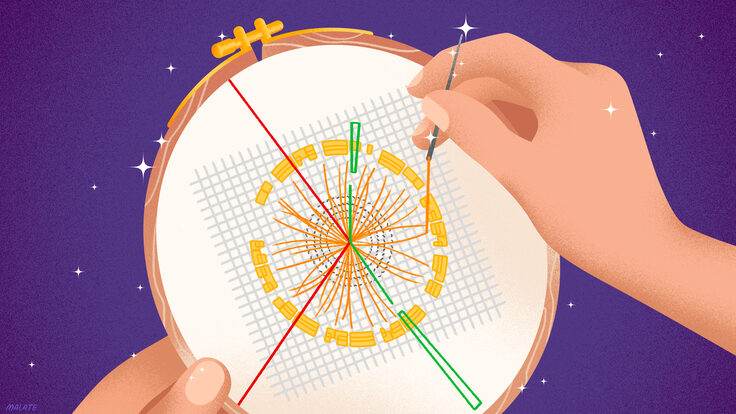This story first appeared in Fermilab Today on Friday, January 8, 2010.

This is just a sample of the many measurements that CMS has made in their studies of charged particles from their recent data taken at a collision energy of 900 GeV. This measurement is in excellent agreement with earlier studies and a similar measurement by ALICE, another LHC experiment. The red points represents the new data and the green band represents the measurement uncertainty.
When people ask me about the LHC and the time it will take to make measurements, I always caution them that it takes a while to understand the detector and they should guard against unreasonable expectations. We will not find the Higgs boson in the first week of running.
However, while a paradigm-shaking discovery might take a little while, we should remember that the LHC did deliver a million collisions to the four detectors at an energy of 900 GeV, as well as a smaller data sample at 2360 GeV.
In the last Result of the Month, I showed that we are starting to rediscover familiar particles. This is a necessary first step in understanding our data. However CMS physicists are going much further than that. With this first small data set, we are making publication-quality measurements.
One universal feature of high-energy particle collisions is that many charged particles are made during the interaction. When an experiment first begins colliding beams, the first thing physicists must do is to study these particles to verify that they have the same range of energy and spatial distribution as earlier measurements. In addition, it’s important for physicists to verify that the right numbers of charged particles are produced in each collision. Failure to verify could indicate a failure of the equipment or (and this is far less likely) a discovery.
After studying several of these distributions (only one is shown here), the CMS results are in excellent agreement with earlier measurements and these results are likely to be CMS’ first publication. The speed at which these results have become available is a testimony to all of the hard work that has gone into designing and building the equipment, the grid computing and analysis software, as well as the enthusiasm and expertise of the analyzers.
They say that the journey of a thousand miles begins with a single step. CMS has taken that step.
by Don Lincoln

The CMS group at MIT, working with a team from Budapest, has applied their expertise learned while working on the PHOBOS experiment at the RHIC facility to provide this quick and valuable measurement. From left to right: Ivan Amos Cali, Yetkin Yilmaz, Yongsun Kim, Ed Wenger, Yenjie Lee, and Frank Ma, from MIT; Gabor Veres, Eotvos Lorand University & CERN; Tae Jeong Kim, SungKyunkwan University; and Christof Roland, MIT. Also involved in the analysis, but not pictured: Krisztian Krajczar, Budapest; Constantin Loizides, MIT; Gunther Roland, MIT; Ferenc Sikler, Budapest; and Andre Yoon, MIT.







